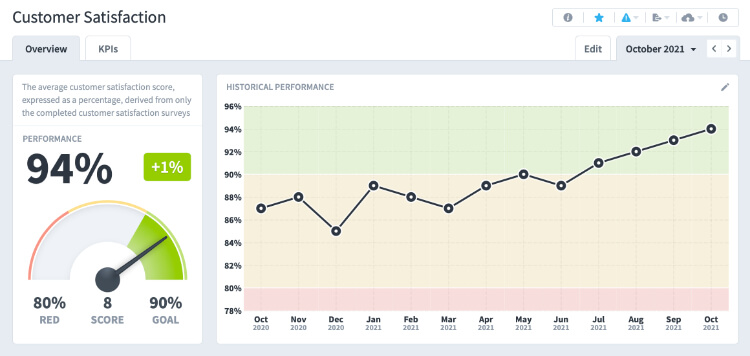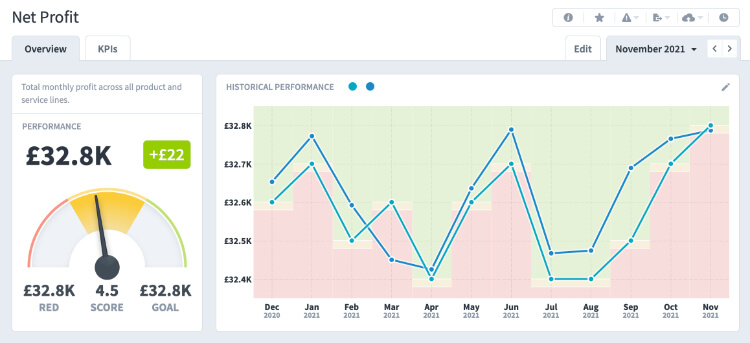Over the next few weeks, we are going to take an in-depth look at Key Performance Indicators, commonly known as KPIs. We’ll begin with a KPI overview and explore the importance of setting KPI targets, known as ‘thresholds’. We will then examine a set of specific interest areas that will build a strong understanding of why you should use KPIs in your organisation.
Setting the context for KPIs
In recent articles, we have focused on the broad topic of business strategy. Having understood the high-level, long-term and overarching nature of strategic development, we now turn our attention to the ‘ground level’ of the organisation and seek to understand how we can measure business activity to demonstrate success and achievement of strategic goals.
So what exactly is a KPI?
A Key Performance Indicator is best understood as a performance measure that organisations use to track progress towards strategic objectives and goals. By nature, they are used at a business level, rather than an individual level. KPIs can be used to measure repeatable operational activities, but these tend to be called measures or metrics rather than indicators.
What is the value of KPIs?
It is vital to understand that KPIs have no intrinsic value in their own right. In fact, their value is only realised when they are linked with a strategic objective or goal. This goal – and the linked KPI – can be specific to a department or function, or to the organisation as a whole. For this reason, the choice of KPIs needs to be consistent, so that the set can be used effectively when upwardly managing reporting and decision-making through departmental, divisional and organisational levels.
How are KPIs managed?
Most organisations will use a proven and standardised methodology for KPI management. This could be a methodology like the Balanced Scorecard. The Balanced Scorecard provides a robust and user-friendly framework that enables consistency across an entire organisation. You can find out about this methodology here – What is the Balanced Scorecard – The Balanced Scorecard, or BSC, is used by 50% of large organisations worldwide to manage business performance.
How are KPIs different to regular business metrics?
A KPI is selected for being ‘key’ to the underlying strategic goal or objective that it measures. It will be a measure that can be compared, counted and used to evidence the degree of objective attainment (or lack thereof!) A KPI will also be used within a defined and specific time period, and be objective in its nature. KPIs can also be compared with benchmarks or comparators in order to provide a broader context and genuine interpretative value.
It’s vital to clarify the differences between a KPI and a regular metric because no organisation can keep a close eye on everything that is happening across the entire operation. The executive team must be in a position where they can focus on selected priorities – ensuring the strategic wellbeing and long-term viability and success of the business. This means that they must focus on the KPIs which support strategic goals and objectives, in simple terms, to keep their eye on the ball. This is often aided by presenting KPIs within a regular dashboard for ease of review and analysis by decision-makers. If, upon review, these high-level KPIs flag up any degree of concern, they can then be further analysed; drilling down to supporting and base level information to see if the agreed tolerance level or success measure isn’t met.
KPI overview comparative thresholds
Although the concept of KPIs is quite intuitive and easily understood by managers, the subject of comparative thresholds is less well known. And yet is absolutely vital to the success of KPI measurement and assessment. A KPI without a benchmark or a comparison lacks value. To extract meaning, it must be compared to a defined level of good, or at least acceptable, performance. A threshold can be defined by agreed theoretical or desired values, based on earlier performance or benchmark data. Alternatively, they can be predicted based on anticipated future performance. By setting these performance thresholds in advance, an alert can be automated to occur if their outer limits are breached. Additionally, trend information can be gathered over time by gathering historical data and using it to support informed future decision making. In the example below we can see that the KPI Customer Satisfaction has an upper threshold of 90% and a lower threshold of 80%. This is typical of a KPI whose target values remain consistent year on year.
However, when dealing with monetary values such as Revenue or Profit or numerical values like Number of Sales or Number of Members, then the thresholds may be determined by a monthly forecast or budget. This can be seen in the example below, Net Profit:
Where do you start with KPIs?
Many businesses make the error of focusing immediately on KPIs. It’s understandable, as their tangibility and potential power feel like an obvious way to implement immediate action and improvement into an operation! But remember, a good set of KPIs can only be developed through a sound understanding of the organisation’s intended direction. Know where your executive team are steering your business before clarifying the roadmap to get there. The first step, after setting this strategic direction, is to assign agreed objectives and goals and only then use these to generate meaningful KPIs which will help to track and manage progress.
Find out more
Please contact the team at Intrafocus to find out more about strategic business planning, KPIs and the Balanced Scorecard. You can also download our e-book; How to Create Meaningful KPIs. which provides an excellent KPI overview.




